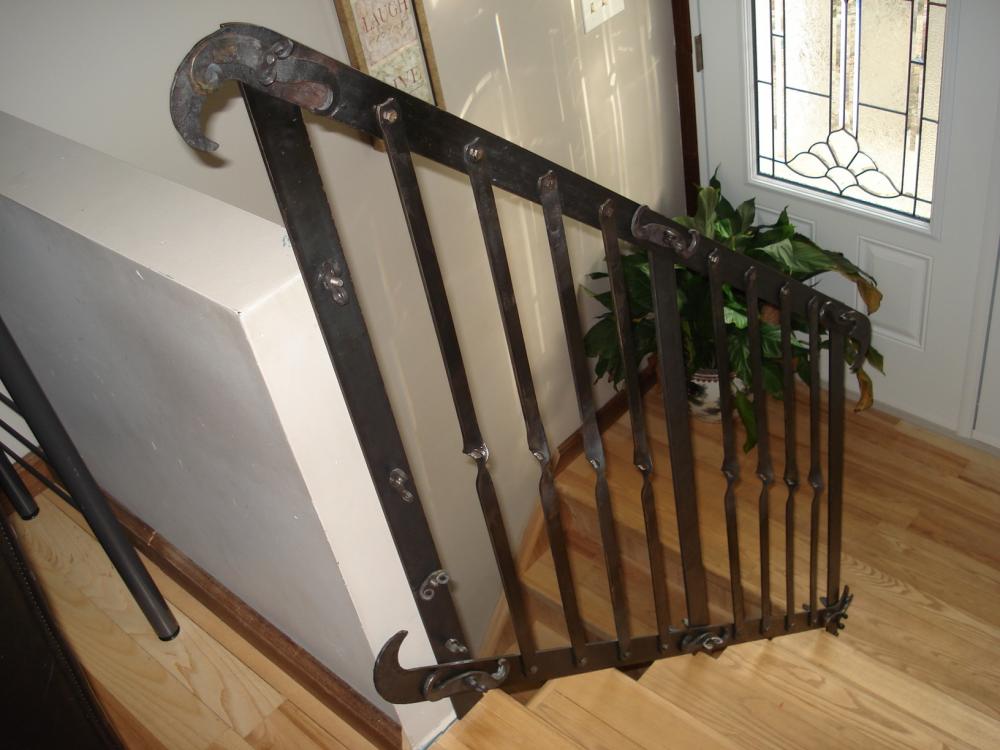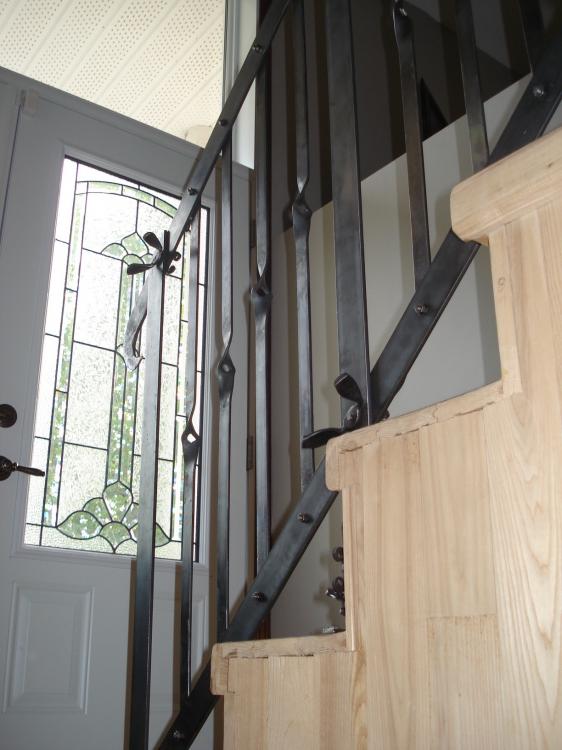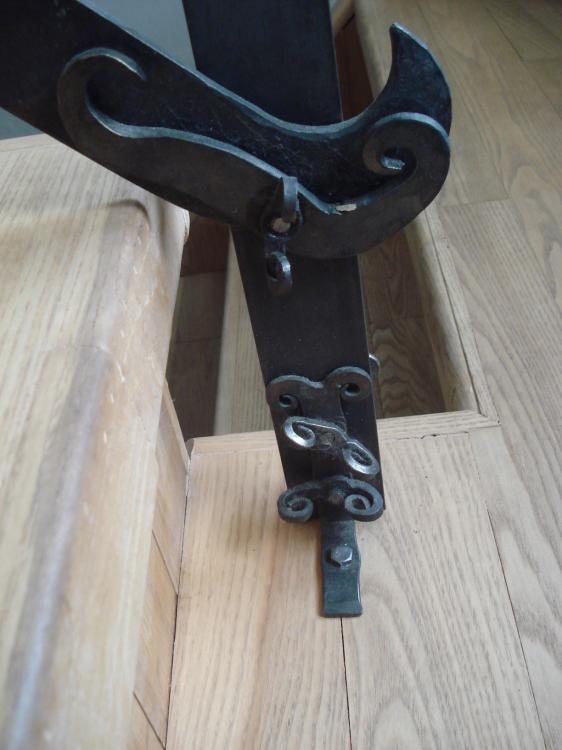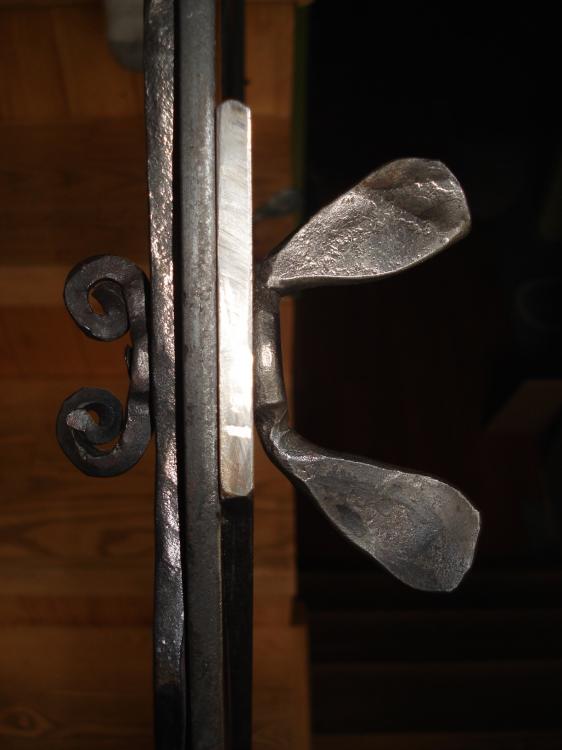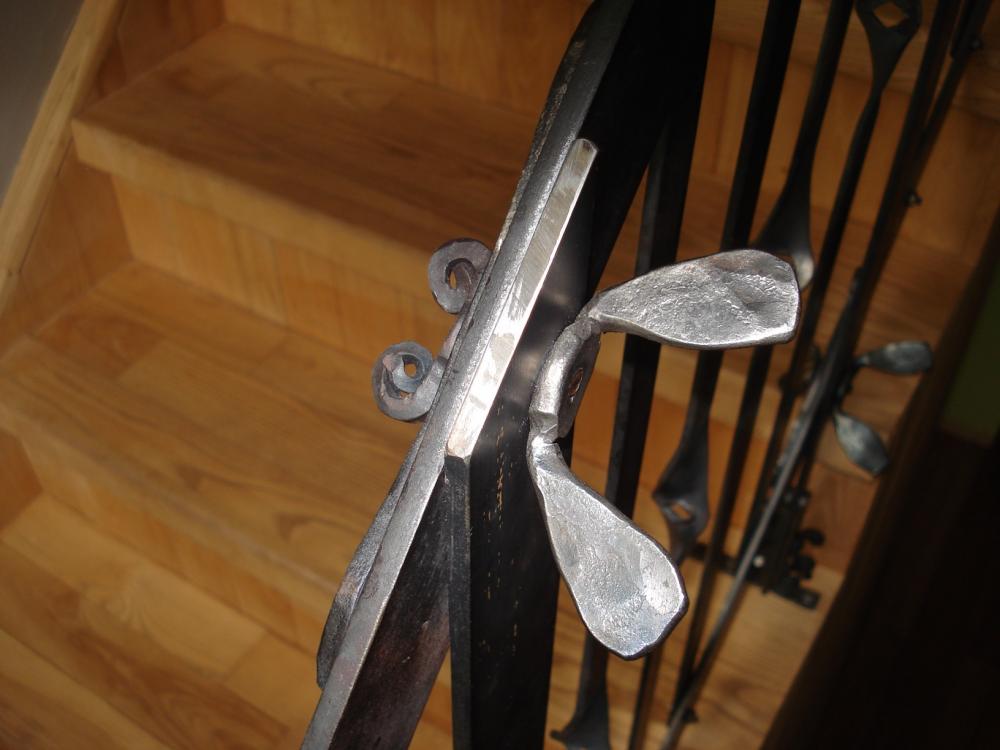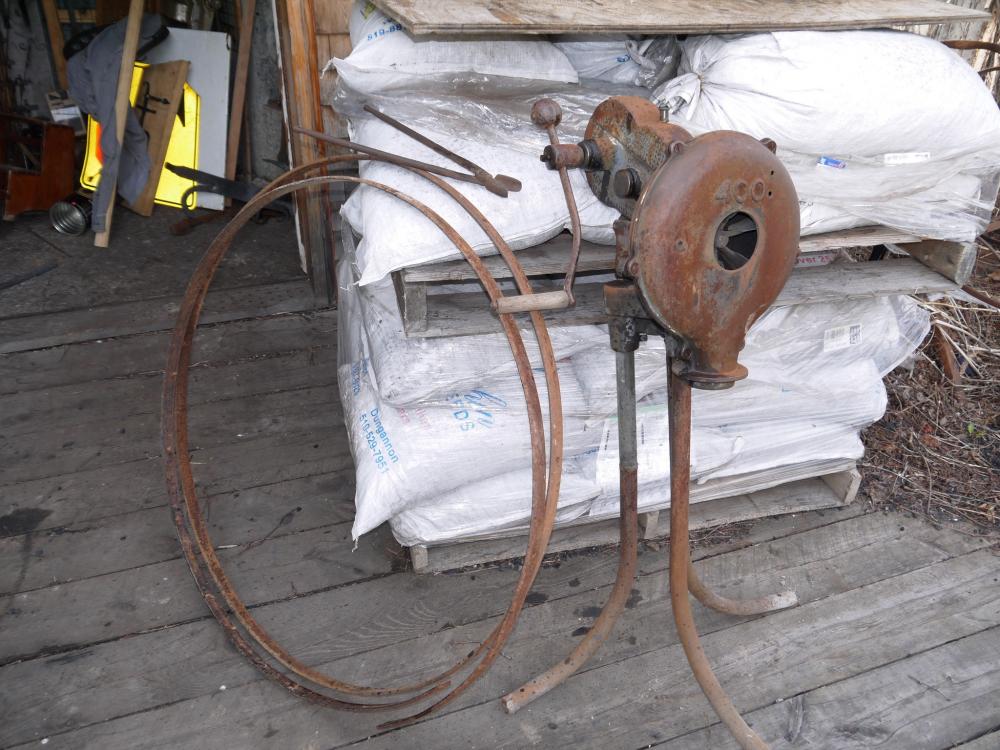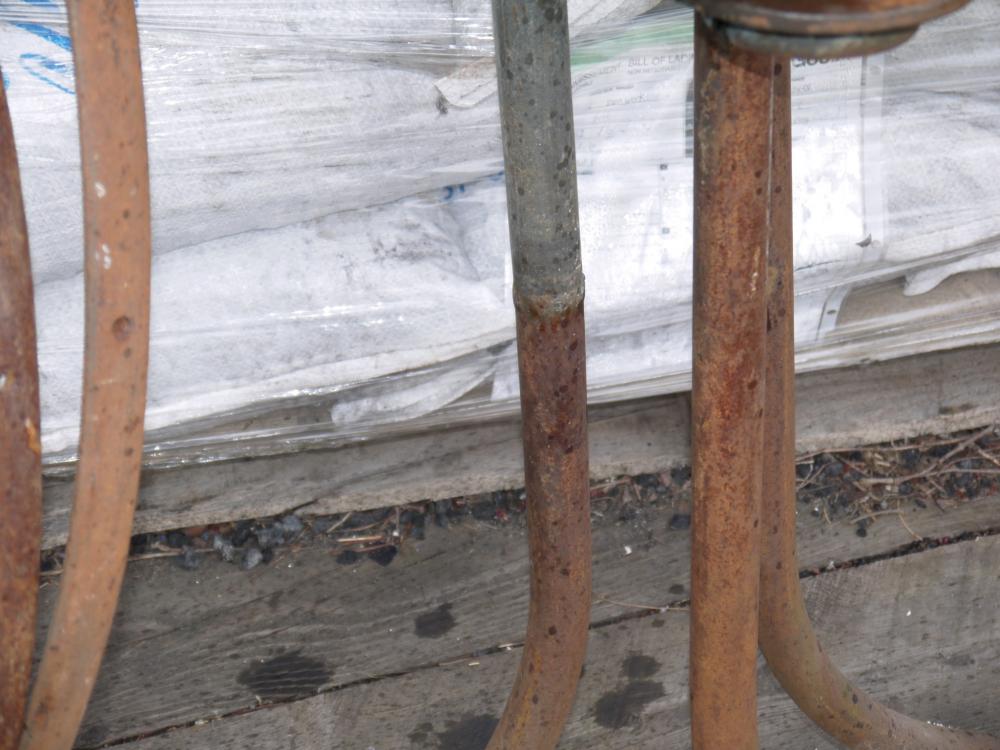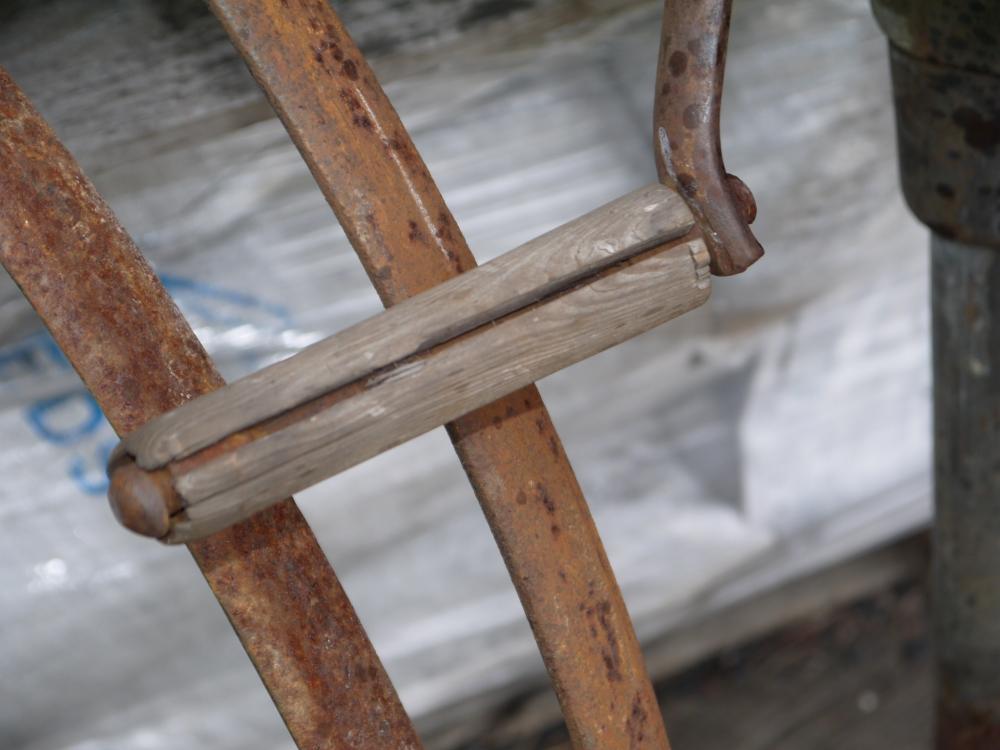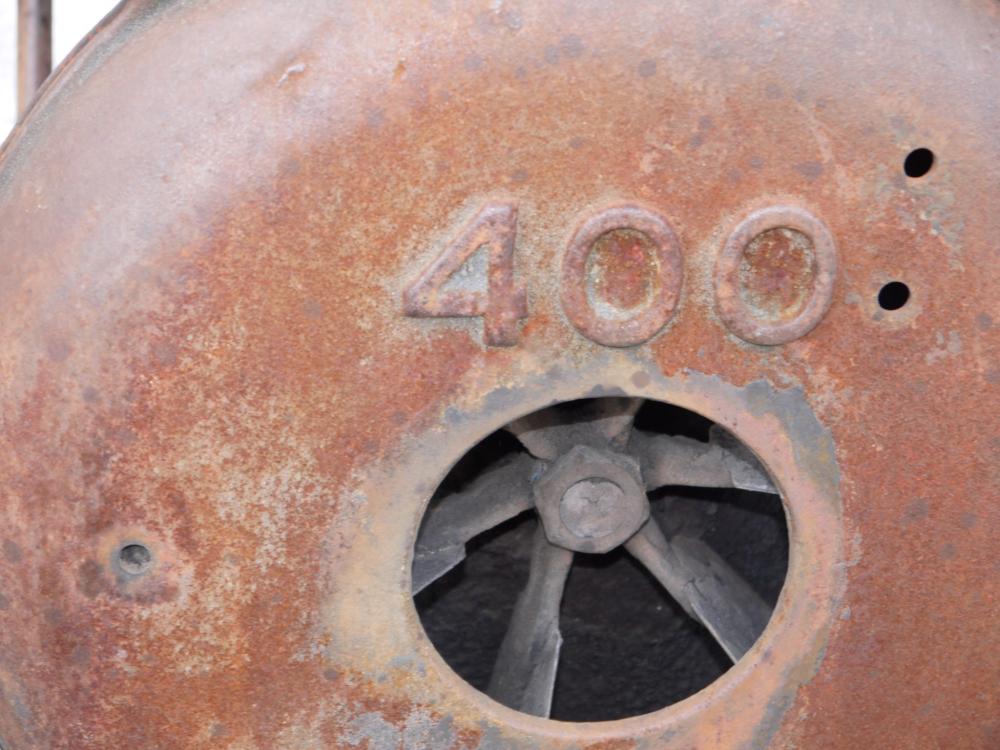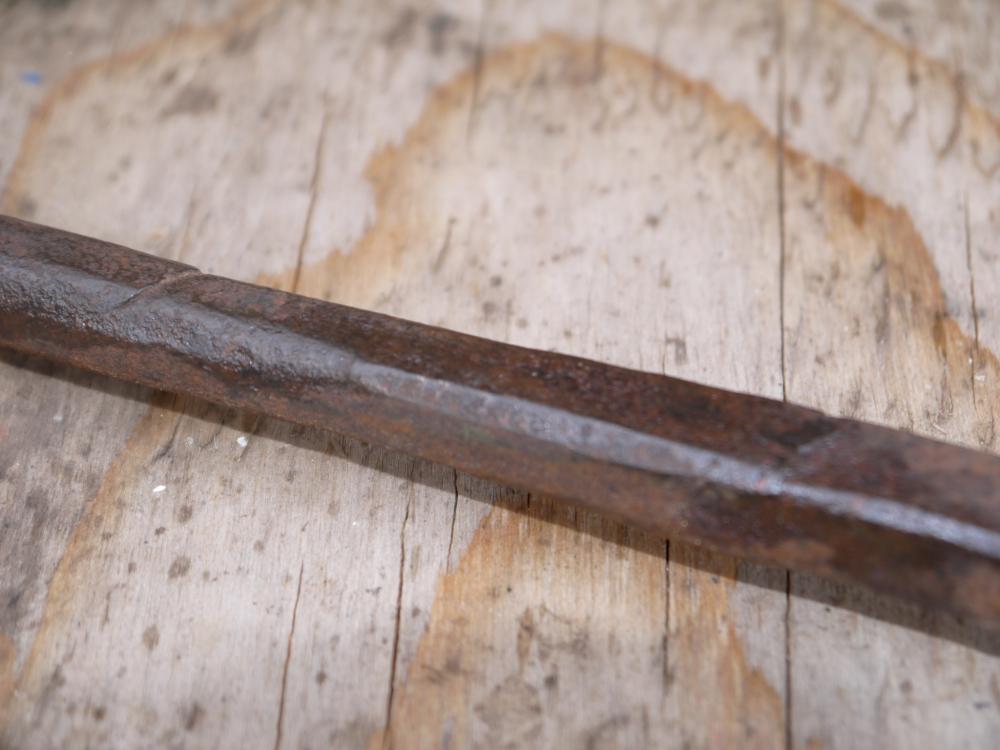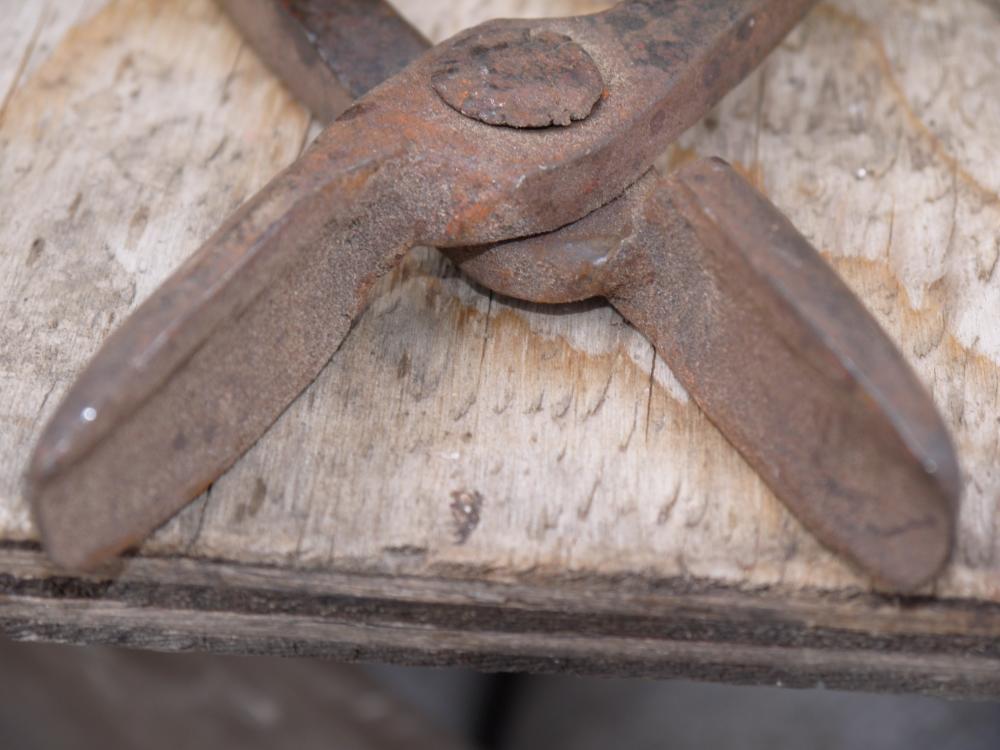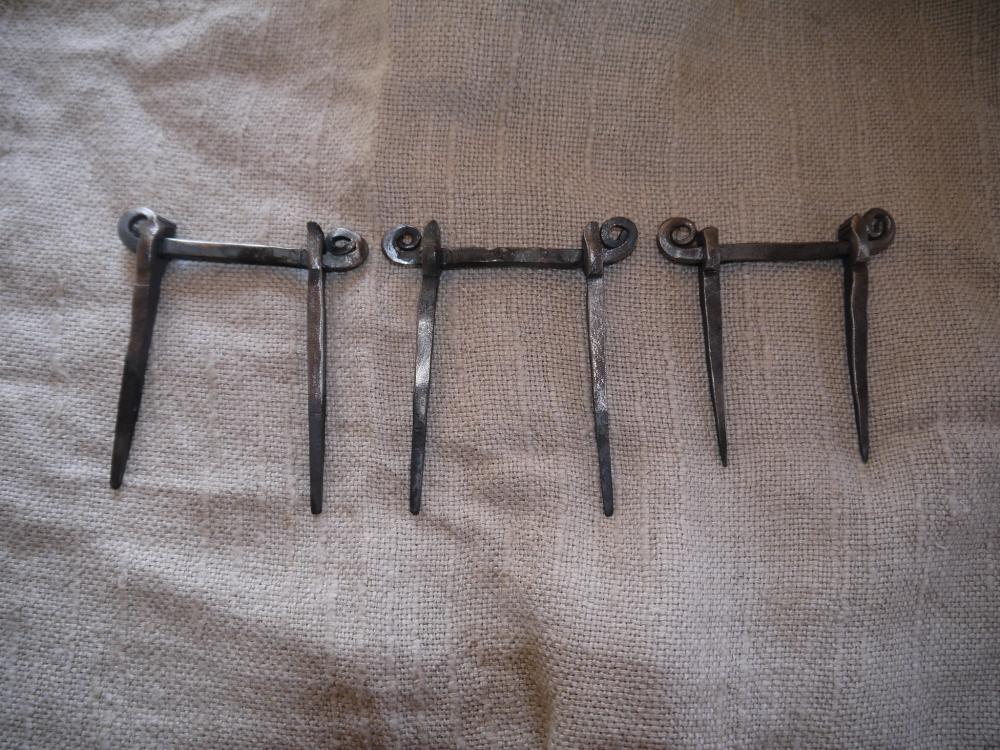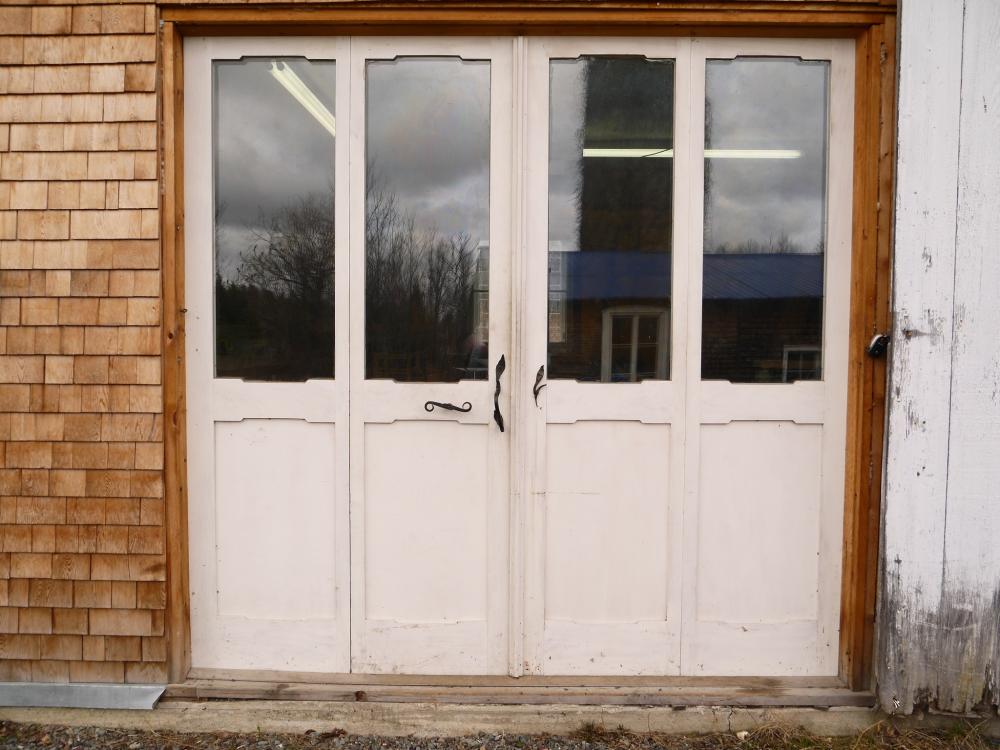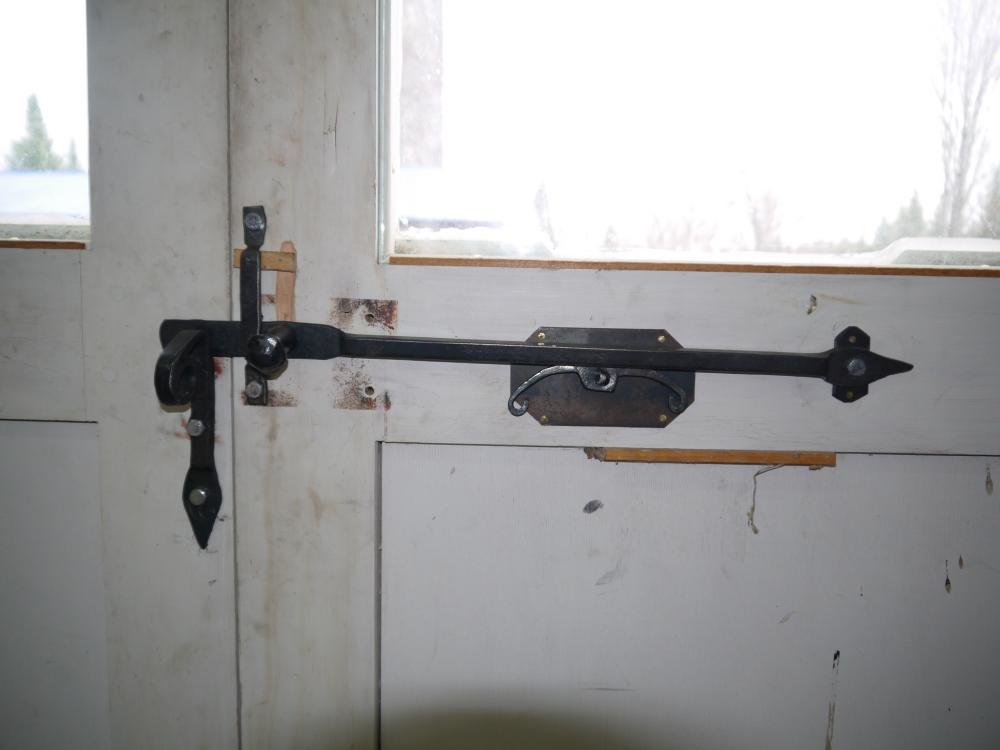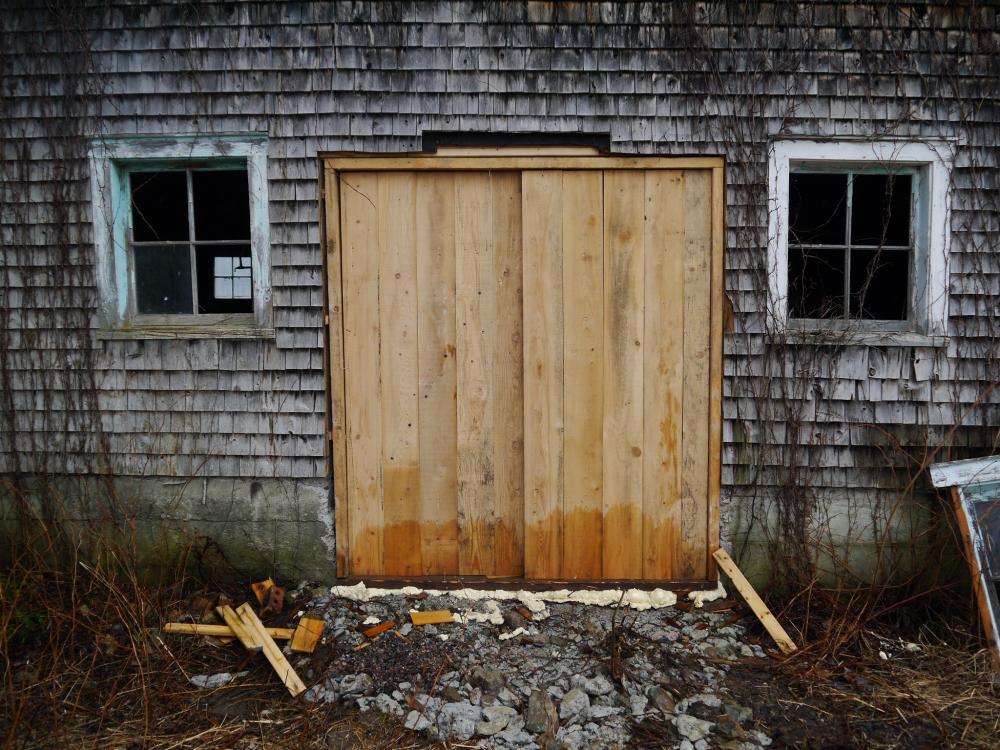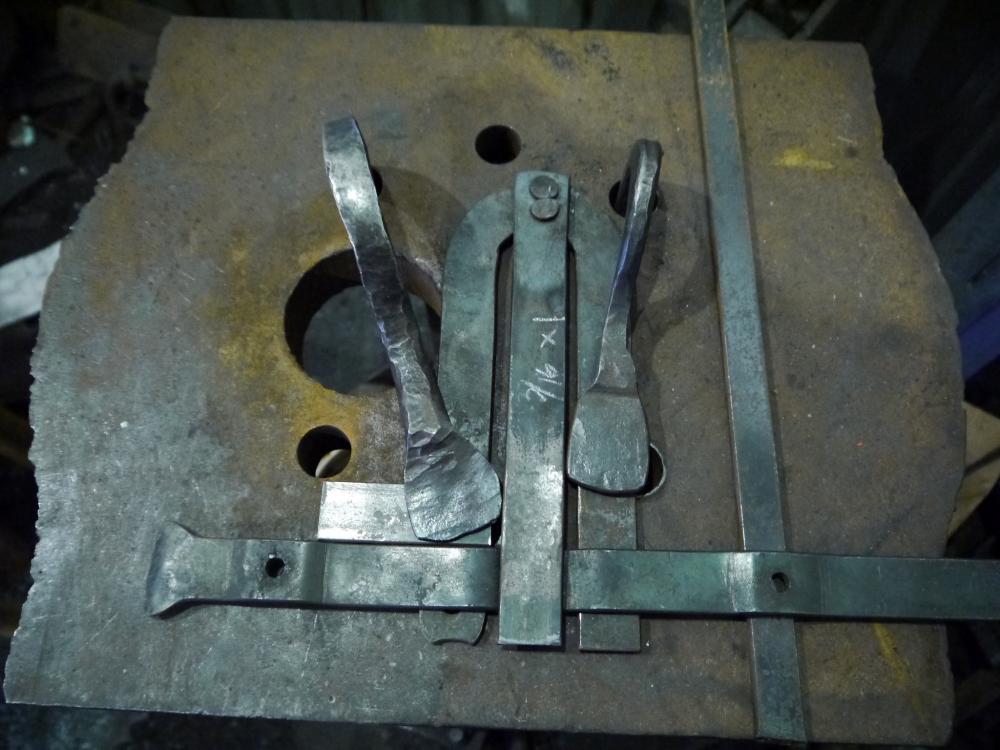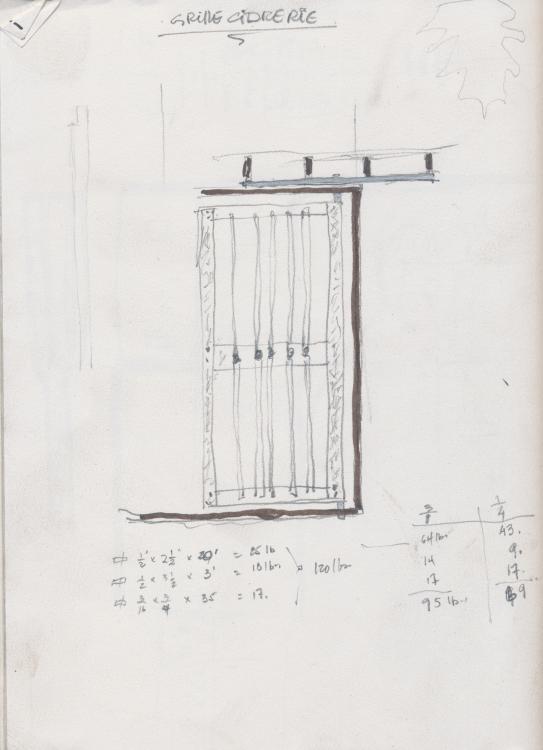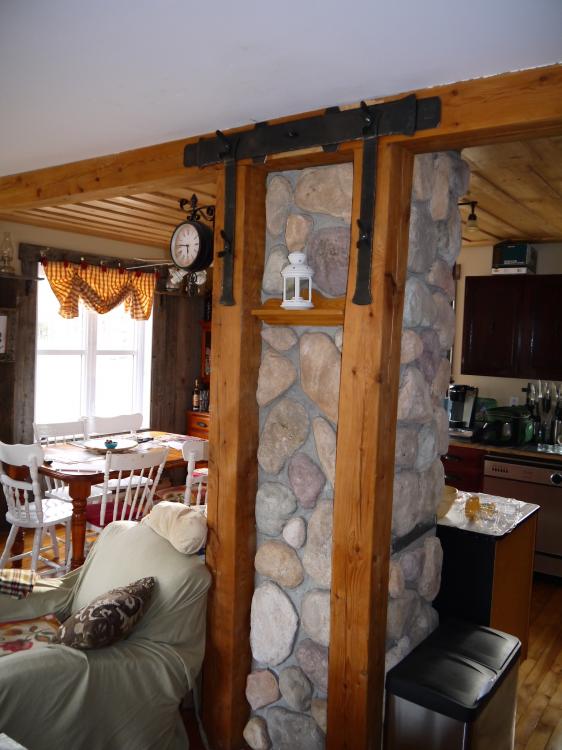-
Posts
564 -
Joined
-
Last visited
Content Type
Profiles
Forums
Articles
Gallery
Downloads
Events
Everything posted by yves
-
When I got the commission, I was not sure that I still wanted it! I had never done a handrail before. I remembered I had seen in an ABANA publication a blacksmith making a story stick of the stairs he was to fit a handrail on. In woodworking I used these all the time and they never failed. And that is what I did. From the story stick of the stairs, I could draw my handrail to 1:1 easily. Here is what the drawing looked like after being used to adjust the parts. I never thought of taking a pic when it was clean... It worked. The whole thing fell in place without a hitch. maincourante PD1 installée - 12 sur 12.m4v Here is a view from the top ... obviously : The forged holes lighten up the structure and the twist gives some movement. The whole structure is held together with bolts (black) and small wing nuts as seen in Plummer's Colonial Wrought Iron. The large wingnuts are Uri Hofi's. The structure is bolted to the floor and fastened to a side wall with hanger bolts and the small wing nuts as shown in the first pic. The clients fell in love with a scketch in my drawing book. I warned them that it was surely not in accordance with rules and regulations and that their insurance company might also object. They decided that this is what they wanted. The client is to wax the steel. This was a low budget commission.
-
Ditto. So elegant.
-
Alan, By the way, they were and maybe still are used in Champagne. Of course everyone knows that the gases released by the bubbles are not toxic in any way ...
-
According to Lecoq ("Les objets de la vie domestique"), there were three styles of candlesticks : female (with a cup), pinched with tongs and the male style where the candle is stuck on a point (these were expensive and mainly used in churches and chateaux). The cup system (female) appeared in the 14th century. Some cups were fixed and some were mobile. Most often, the latter was of the spiral type the same as the so called "courting candle". Wine makers in Burgundy especialy used these and still do claims Lecoq in 1979. They were used to detect the presence of toxic gases in wine barrels. Inserted in a barrel, the candle would die out in the presence of such gases. In France at least, they seem to have been part of the wine making process rather than part of a family surveilance activity which is not mentioned by Lecoq .
-
Brass hammer.
-

Do i have to be artistic to be a blacksmith?
yves replied to Seth O's topic in Blacksmithing, General Discussion
About drawing : when I started, I could not draw better than you claim you can. But when I wanted to do the type of forging that appealed to me, I started drawing. I have a grand daughter who apparently was born able to draw but she does practice. She draws all the time. I was not born like that. So I started drawing a lot. After a couple of years, I can draw enough to present options to my clients. It is something you can learn. Practice. Just start doing it. You will be surprised. -
One morning, walking on the bathroom, I suddenly saw my father in the mirror. It was I that had taken his or is it our shape. My father was a heavy man with no health issues at all (died in a car accident). I spent my life at 185-190 and when my shape changed, I worried. However, every second year I have my young doctor repeating the same thing : "Everything is fine. You should reduce your waist and do some exercise for the cardio." And every time I ask how was my blood pressure. Fine she says like a teen's. And my reply is that I just climbed the stairs to get to her office. You are right SmoothBore, it is a mental health issue. I am not worried that I got heavier which does not seem to be a problem after all. What I was more worried about was that shape I lost. But you cannot get that old without something changing and this getting old thing is better than the alternative. So to the gentleman that started this topic, get into blacksmithing because it's a lot of fun. And if you want to make a little money to at least pay your hobby, you are better with metal that with wood. With a piece of flat bar 3/16 x 1/2 x 5", I can forge a little cubboard door hook sold at 8$. Try doing that with a piece of wood of the same size! You might not get thinner with blacksmithing but neither will your wallet!
-
Let me put it to you straight and clear. I got old and stopped smoking and I got bigger in the bargain and topped at 210. Then I "retired" as they say so I could do what I wanted. I got into woodworking every day all day and still weighed 210. I had a car accident, spent 3 months in a hospital and went down to 200. Yeah. I looked great. After a couple of months or rather weeks I was back up to 210. I could not work for 3 years rolling around in wheel chairs and pushing my weight on walkers. I stayed at 210. Every 2 years I go to France for 6 weeks or so. Once, I came back at 248. Came back down at 210. Every 2 years! This year however, I came back from France at a measly 225. Now I'm back at ... guess what ... I got into blacksmithing. Been at it for 4 years now, most every day all day (blacksmithing is not only hammering iron or steel). I'm still 210. A couple of weeks ago I started working in the woods 1 day/week for the cardio bit.That will not take me below 210 I'm sure of it. It only permits me to find new spots to feel pain. It seems the only way for me to get back down to 200 or 190 would be to ... no it's not blacksmithing ...
-
Smoothbore, I thought about hitching Prince-Edward Island to a couple of tugs and pull it down in the vicinity of THE Islands. I could not do it aIone and I could not find anybody that had sufficient ... faith is it? ... so I am stuck up here fighting with oil that is not supposed to freeze. If you would mail me what I need I would be indebted to you.
-
Frosty, -30Cº is not that bad if you dont have the wind blowing between your legs and you are dressed properly (wool). I'm sure you know that. I have a wood stove in the smithy. It does cut down the humidity but it is generaly useless since I have to open the door of the smithy my sidedraft being 14" square with a 12" square chimney (it works so well, the chimney, that you do not want to bring your grandchildren next to it. There is a danger that they would be sucked up there and disappear in the ether ...) There is a lot of air going up there. I have to bring as much in. So I open the door 2-1/2" or so. Its not that bad at the forge and the anvil, but one more step towards the door and what I do not know how to name so as to not be offensive on an American family forum, get very small and come up as far as they can! This year, if commissions keep on coming like they do, I'll install the heaters they use on restaurant terrasses in Montreal. They heat the objects (bodies being objects) but not the air. They are 650$ down here and live on 240v juice. To operate, they cost about as much as a floor lamp in a broth... closed house ... as the French say. This year, the cold never let go and it cost me someting like 8 weeks of working time. It stayed around -30 Cº/-20Cº for weeks. I can't realy remember and do not want to. It was quite depressing. And the wood pile was going down and still does by the way. I can't affoard that. I will get the heaters. Thanks for the info on oils that I can and ought ot use. Bear with me ... Our bears, like I said are nowhere to be seen in my parts of the country. I could grease a telephone pole with bacon slop and only my cats and I, maybe the neighbor's dog, would stop to have a lick ...
-
Frosty, I did not know the name of the oil cup. I do not even know it in french. I am mechanicaly challenged, more, mechanicaly impaired. I do not dare take the blower apart alone : not sure how it goes, not sure I have the proper tools, not sure period. So I go to a friend's place. He does the job, I supply the conversation. By the way, our bears are brown, the small guys. I never saw one, only poop once, a few years ago. But whatever bacon there is, I would not give to a machine, I eat it . I asked for an oil that does not freeze. They sold me one. All I can say is that it may not freeeze but it sure becomes heavy at -30Cº. What would you recommend along these lines? I think I have transmission oil in my blower. This second blower is to be used outside of my silo and at demos I plan on giving or is it selling?
-
I had heard of the gentleman but somehow never dared to go and ask. I dared and came away with the following : a pair of tongs perfect for the 5/8" round bar I work with these days, a Champion 400 blower in pretty good condition only needing cleaning and oil,and the man threw in two wheel tires. One leg has been repaired. The handle is ready to die but it will probably do so after me, i think. I will oil it. I think the zirt is the original. It is quite loose inside. As can be seen, it is in need of a cleanup. As mentioned, the tongs are perfect for Ø 5/8". They were forged by a blacksmith as is apparent with the forge welded reins. The one I show has two welds approximately 2" apart. I dropped 60$ for the lot. He also told me he could get me a forge. The description he gives makes me believe it is a Buffalo table or something like it. But what is more important, is that he told me without my asking that whenever he comes across blacksmith tools, he'll phone me before selling them. I thing I made a good hit. For up here at least where these tools are few and far between.
-
I will try to be clear. We are the client : we want to make cider for us and the family and we need the gates. To me these gates are to be a show piece. About the rivets Since I want to forge the holes in the bars, forging square rivets does not put me off. I would not have thought of using them but after reading what you all have said, I feel confortable with this solution. And it might add visual appeal. I'll see what happens. I'll forge some. I much prefer one square rivet to 2 rivets per intersection as was also suggested. Two rivets is a lot of company on that rather small real estate. I will give myself some leeway for assembly with the holes forged a little larger than the rivets. About the setting The building is 75 years old give or take. We just opened the wall. I will probably make the molding in steel. Just an idea. The gates will be behind the shutters in the following pic, in the middle of the frame (I will add inside doors for the winter). The inside of the frame is 6 feet wide and 7 feet high. The frame is made of 2 x 8 screwed on the sides to the jambs. To the bottom of these shutters, I will add large decorative drop breaks as I have admired in France because they were beautifull and because they were at their job of protecting the door for more than a hundred years. I'm safe, I will not have to change them. These shutters will open on the following hinges or something like them if I can ever find out how I forged that one at the end of a day for the fun of it. This is 3/16" x 2" flat material. The eye is forge welded. The hinges will be affixed to the shutters with clinhed forged nails (I forge two every morning) and with the collars of the following pic which will also be clinched. There will be 3 hinges on each side. Two things are to be worried about as all the posts have made clear : the weight of the gate and the joggling of the bars. About the weight. I was looking at the doors to my woodshop. They are (one half of the doors) 4 feet wide and 7 feet 9 inches high. I calculated that they weigh in with glass and bottom pannel, at 66 pounds. They are 12 or 13 years old and they never sagged at all. The latch always works smoothly. It almost sounds like that famous Volvo door. ... I know, I ought to change the lag screws for black ones .. . I also calculated that a gate somewhat like in the following drawing (not to scale) would weigh in at 120 pounds if it were forged with 1/2" x 2-1/2" for the uprights and the top and bottom cross bars and 1/2" x 3-1/2" for the central part.The same gate would weigh 95 pounds if it were forged with a 3/8" frameand 69 pounds with a 1/4" frame.I am looking at 2 options here : I know about wooden doors, made a lot of them and would easily keep the style of the woodshop doors only replacing the glass and the pannel with the grille. That door would weigh between 85 and 90 pounds which is quite close to a steel gate with a 3/8" frame. However, screwed to the frame with piano hinges like the woodshop doors, nothing would sag and the frame could easily take it;the second option is to go with the 1/2" steel frame (to prevent warping and add visual interest as was pointed out). In the drawing above, there are two tenons, one on the bottom of the righthand upright and one at the top. The bottom tenon would be forged round on the end and would rest on a ball bearing in a bushing with the end welded shut and installed in the sill of the frame (epoxied) and resting on the cement below. The vertical weight (can I call it that?) would be taken directly under the gate. For the "side weight", especialy when the gates are open, the top tenon goes through a bushing in the wooden frame and into a 1/2" x 5 plate bolted to the door jambs and to the wooden frame (but not to the beams as in the drawing, (I checked : the beams are much too high). When the gates are opened by kids hanging on , the frame which is screwed to the jambs would not budge ... I think ... (and I will probably anchor the wooden frame in the cement on each side, which cement was and is very hard), Maybe I would add a pintle in the middle and an eye forged from the central cross bar. I'll see. It would also add visually while also carrying some weight. Finaly, the idea of adding a decorative angle at the bottom to reinforce the frame is still with me. About the joggling of the bars. Ianinsa, the "some sort of press" I use is the following : You will have recognised Ernst Schwarzkopf's "Form for making offsets" (page 73, fig. 68). That is what I used for the example I have forged that appears in the first post of this thread. There is the Schwarzkopf form and on the right, a piece of steel of proprer thickness and width at the necessary distance to obtain 4 inches between centers. As is apparent, I forge one offset, flip the bar over, set he last offset on the piece of steel and hammer the hot part in the form. I will get my welder to make me another form. It will have all the parts welded together. The top of the form will extend to the right and the piece of steel to measure the distance will be welded on. If you look at the left holdfast, it was put on a piece of steel. This piece will be welded on the new form and another one extending from the right hand piece of the form to and on the side steel. This will ensure that the bars are layed along the same axis and that the offset is perpendicular to the bar. That is how I plan to forge the grille. I think of offsetting both horizontal and vertical bars. As I said, since I need these, I might as well use them as a showcase. I started making drawings of the placement of the bars (heavier at the bottom and on the hinge side). I'll come back with them. If my system does not work, ... well ... I'll listen to Alan and offset only one bar. But it has to work. It will be somewhat precise but it is obvious that it will not have that dangerous precision that would make the grid sag.
-
I have not run away, I'm thinking. And with all the info, questions and recommendations there is a need for some thinking. Like He said : "I'll be back!" ... shortly ...
-
It never ceases to amaze me the quantity and quality of knowledge and the generosity or is it passion ... probably both ... of the people here on IFI. When I first posted my query, I had read some about gates here on IFI and Peter Parkinson's "Forged Architectural Metalwork" but I still had this worry about the possible sagging of the gates. The square rivets or the keyed ones by BFN as Mr Stevens calls him, the corner braces proposed by Glenn and all the analysis of grid resistance to sagging by Alan and his proposal for joggling the bars (not counting the lost sleep about all this), Thomas Powers' suggestion to cut down work time and complications, all these are on the table. Today I do soft work (design for a coming commission, writing down procedures so that I do not have to reinvent the wheel when something comes up again, etc. all these things that are not hammering but part of the job) and I will make decisions as to how I design and put the grilles together. Of course I thank you all and I will come back with a report. I owe you that ... at least. Thanks again. Yves
-
Alan Evans, Thank you for the info. Thank you also for the inspiration. This evening, I will examine the possibility of spacing the components keeping the golden mean in mind. I'll see. I realy like the idea of crowding the hinge side and the bottom.
-
Vertical. Sorry, I should have mentioned. It will look like some sort of prison door. It is to stop dogs, deers and humans from entering a cider (I do not know how to say this, une cidrerie) while letting the doors opened for air circulation. I was counting somewhat on the offsets to help. I would add 3/8" rivets as you suggest and square rivets as suggests Mr Stevens. What say you Arftist now that you know the horizontal span is 3', that I would use 3/8" square rivets. I would like to stay away from a diagonal brace if at all possible. Is it possible?
-
I have a gate to forge, 2 sections of 3' x 7'. The frame I think about would be 1/4" x 2-1/2" riveted. The top, bottom and center horizontal parts would also be the hinges turning on pintles. The open top and bottom spaces would be "covered" by a grille like this one I am examining. The grille (riveted and not bolted like the exercise appearing in the pic) would be riveted to the frame. The grille parts are 4" apart. Question : will such a set-up sag? Do I need diagonal brace or an "X"? I read the "Realy big gates" topic here on IFI where there is probably the answer I am looking for, but it is not realy clear to me. I enjoyed reading about the principles involved and how large gates were set up traditionaly but ... my gates ... what about my small heavy gates ... Thank you.
-
My interest in kitchen utensils of the Nouvelle-France era brought me where I would not have thought it could. A gentleman reading my blog on the subject commisonned me to reproduce leg and arm irons as were used in the same era. I forged arm irons all components in Ø 5/8". The bolt for the leg irons is Ø 1", the schakles are Ø 7/8". I am not happy with the welds on this set which are too visible not that they are not solid, I tried to destroy them and could not but I do not like the look. I tried them on. They are a little tight on my wrists and they produce an immediate clostrophobic sensation. But after all that's probably what they were ment for. It was one size-fits-all. And the guys did not have a choice of colors either.
-
- restraints
- irons
-
(and 2 more)
Tagged with:
-
Time and again, I have mentioned my amazement for your work. My coming back with the same words of praise would be repetitive. But that you have made Frosty speachless and not only once ("again" he says) is as high a tribute as one can express and must be noted. You have set a standard sir. From now on whenever you or someone else produces a work of beauty, the highest praise will be : "Ah! so beautifull as to make frosty speachless!"
- 32 replies
-
- scrapartoz
- wedge tail eagle
-
(and 1 more)
Tagged with:
-
Frosty, I installed this 2 months ago. I took the pics only last evening and posted them immediately. I wanted the pics but also to find out if, after living with the "Thing", they were happy. To shorten the story, let me just say that the lady kissed my bearded cheeks when I left nd the guy tried to crush my hand. Yeah, they liked it and I must say that I liked it also when I walked in. It gives a good impression. It enhances that structure which otherwise was quite drab. I am as happy as the client. Turbo7, Thank you.
-
Mainly, the job (limited budget) was to hide the joint between the beams. The offensive joint: This is what you saw coming in the house. This is what now appears when you enter: The joint has disappeared : The steel is held to the beams and columns with large (and one small) wing nuts I forged following Mr. Hofi's page here on IFI. Face view.
-
Thomas, He seems to have passed the exams but failed to learn.
-
I had a student of mine from more than 30 years ago come and visit me. He insulted me. The night he came at the house, I gave him madame Simm's book to leaf through. The next morning, he wanted me to forge him some nails. Not feeling good that week and that day, I offered nails I have (I always forge 2 nails in the morning to get into the flow of forging). He wanted to see it done, he wanted to see me forge. I gathered my poor old body and brought it to the forge wanting to oblige and surprised he could not see I was not in the best of shapes. When I got the rod for his nails out of the fire, he said : "Ah! That's the way it's done. Easy." I thought it was a joke. I forged a couple of nails. Then he wanted large wing nuts I had forged. I sold him a few. He wanted me to stamp my mark on them. I heated the nuts and stamped them. Since the way I forge the wing nuts there are no flat surfaces, the punch mark was not equaly stamped. He was not happy and wanted me to stamp them again. I explained that I could not hit the same place without deforming the punch mark or the wing nut. He said "You did not bring the metal to the white heat". Remember that he had leafed through the book. I explained that you do not need a white heat to stamp such a mark. When we were in the house again, he said like a sulking child : "I would have liked to forge the last nail".Was it the accumulation of cultivated ignorance, the sulking from a man his age, I lost it. We are talking about a man who is more than 50 years old here. I told him that the nails he saw were part of the second thousand of nails I forged ; that I threw away more cans of nails that I want to remember (those that were forged in five heats and were never nails) and that he could not have forged a nail in the 2 days he was staying with me ; that forging is not putting rods in the fire and taking them out and that no, it was not easy and that I did not take kindly that he would tell me what was the proper heat to work at ; that knowing about forging (a knowledge he did not have) and forging are different things ; that forging is an action, something you only get to know-how a little more every day by doing ; I closed by telling him that I would only let him use my anvil and fetish Habermann hammer if he deposited 2100$ on the table in cold cash and that if the shape of any part of my anvil was changed by him, he would have just bought a used anvil! That sort of cooled the atmosphere. I was happy when he came to visit his old philosophy teacher. It does make one proud to be remembered kindly since you do not realy know what you are doing when you teach, what impact you have on young adults (or is it old teens). But this man was still a teen and behaved in a way that demanded how would you say this ... scolding? ... put in his place? Well I did that like I have done it 30 years ago where he seems to have remained. To ask for knowledge be it in philosophy or forging one has to be an adult whatever age he may be at. And if at fifty or at whatever age one still belongs in a kindergarden, he should be told so and asked to come back later when he is out of there. Of course this could help a teenager who realy wants to learn. It is of no use to a 50 plus year old man who thinks, like a child, that he is the center of the earth. Rereading this post, I sound quite serious. In fact I was. But when he was gone I smiled and thought that I had missed out on that one. I hope I'll get a signal from one of the ones I succeeded with someday.
-

How do I get in to blacksmithing?
yves replied to Kromac's topic in Blacksmithing, General Discussion
Now this is brilliant! I only post here in order to repeat this.

